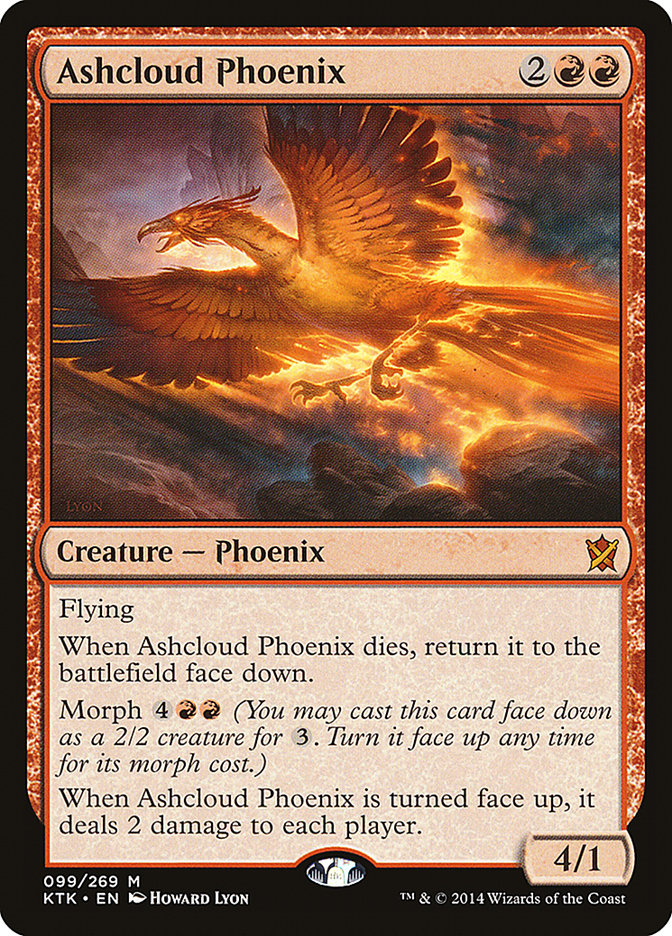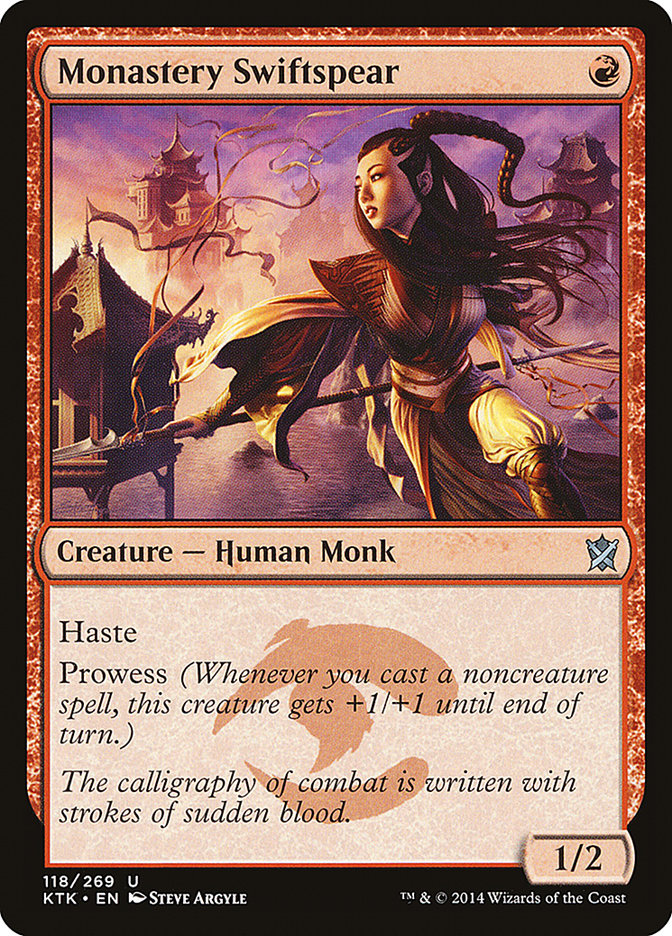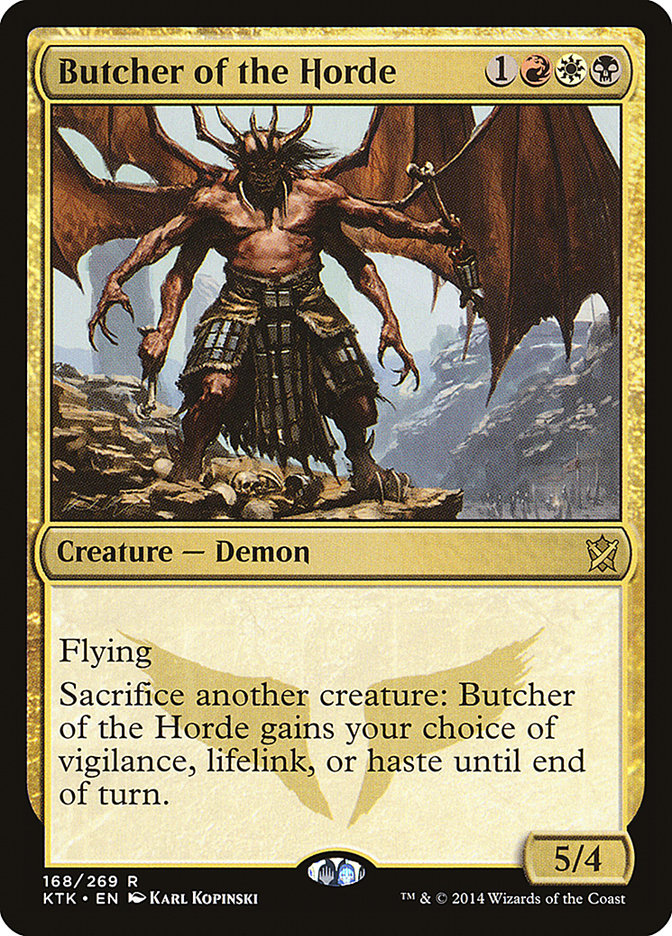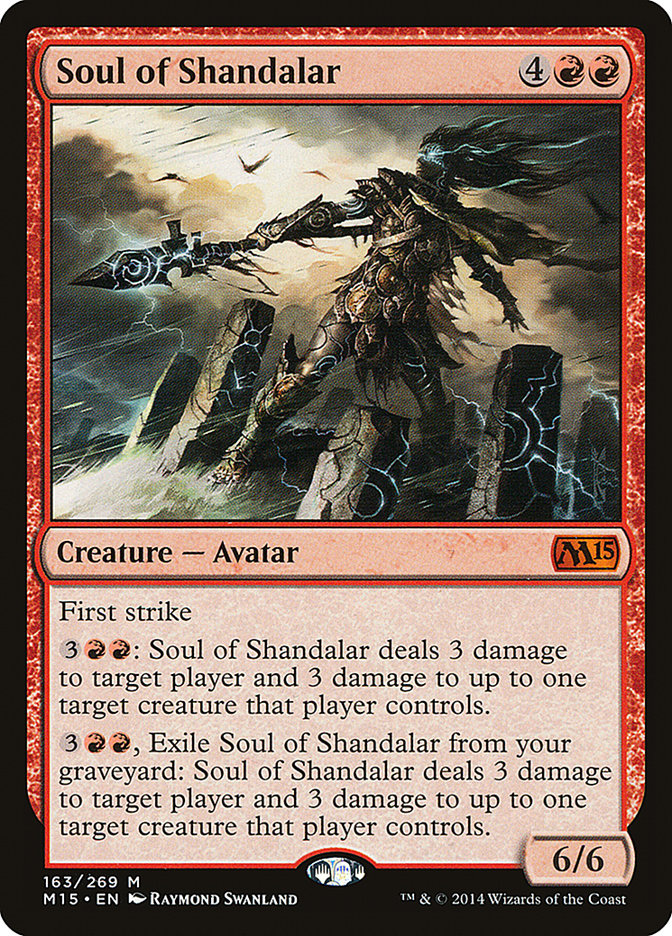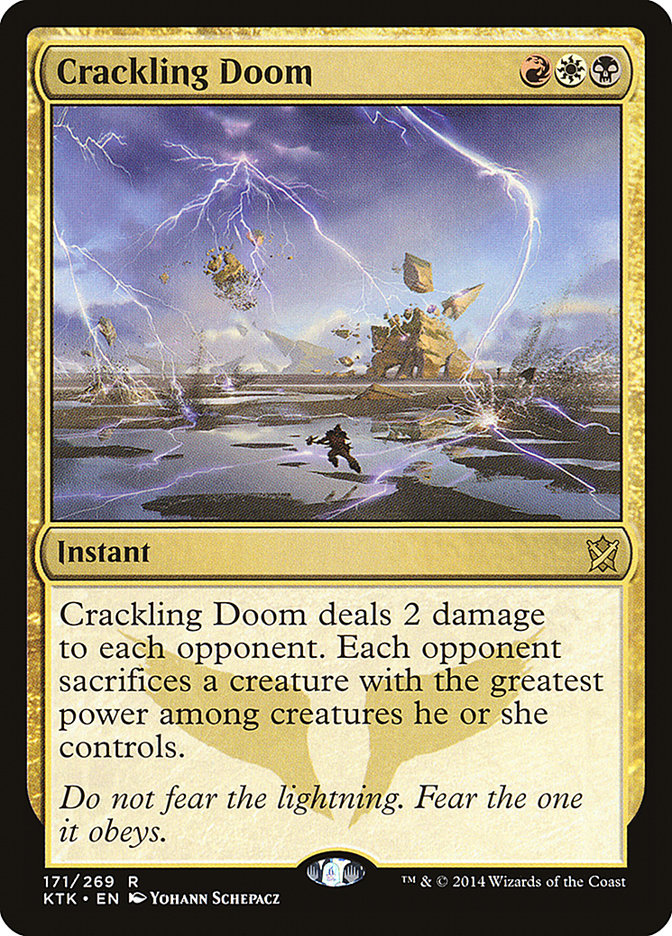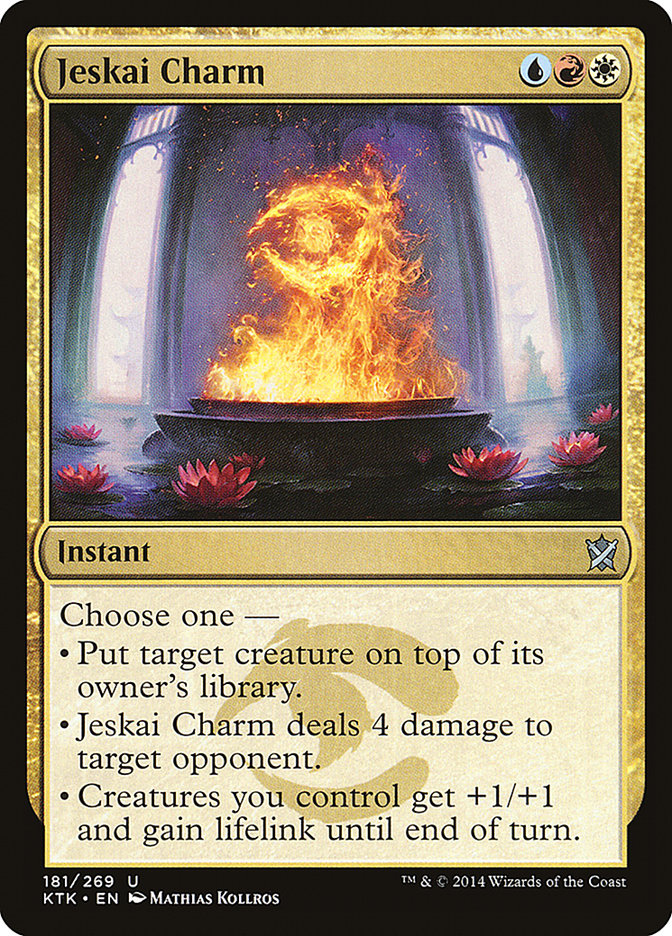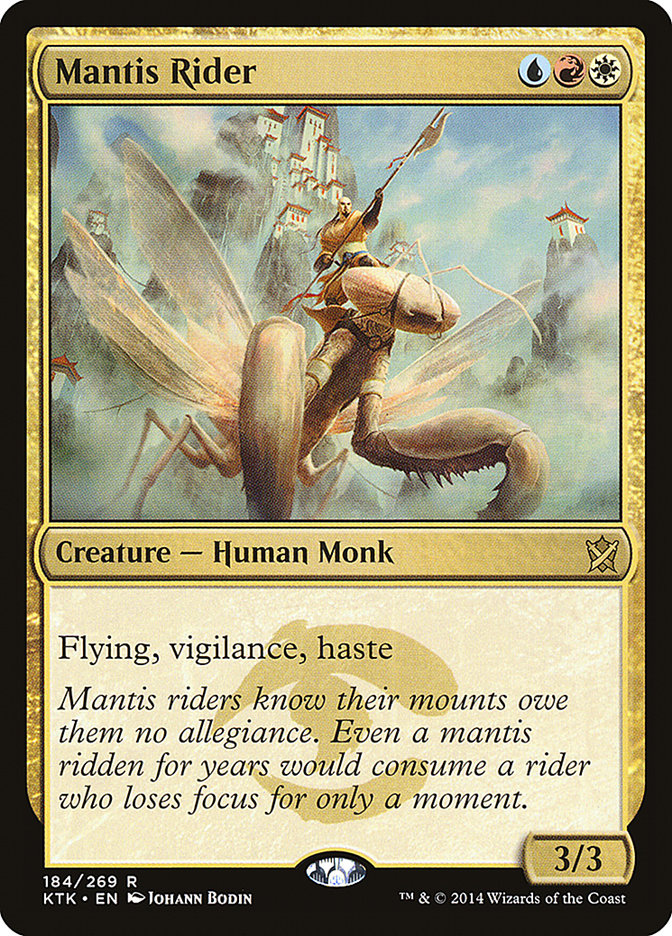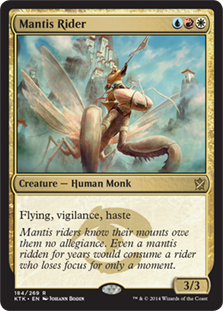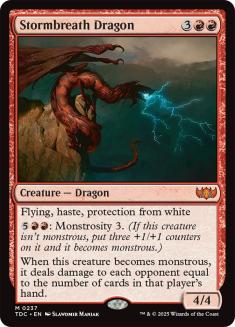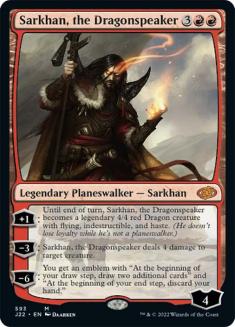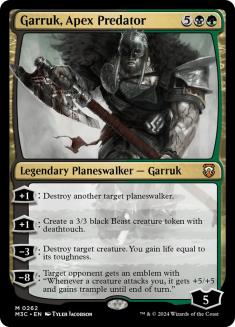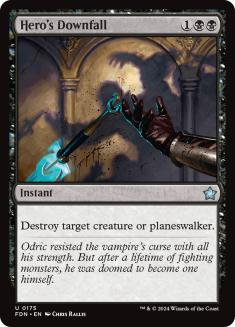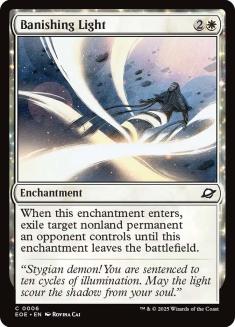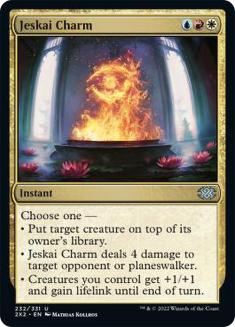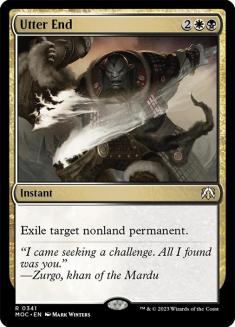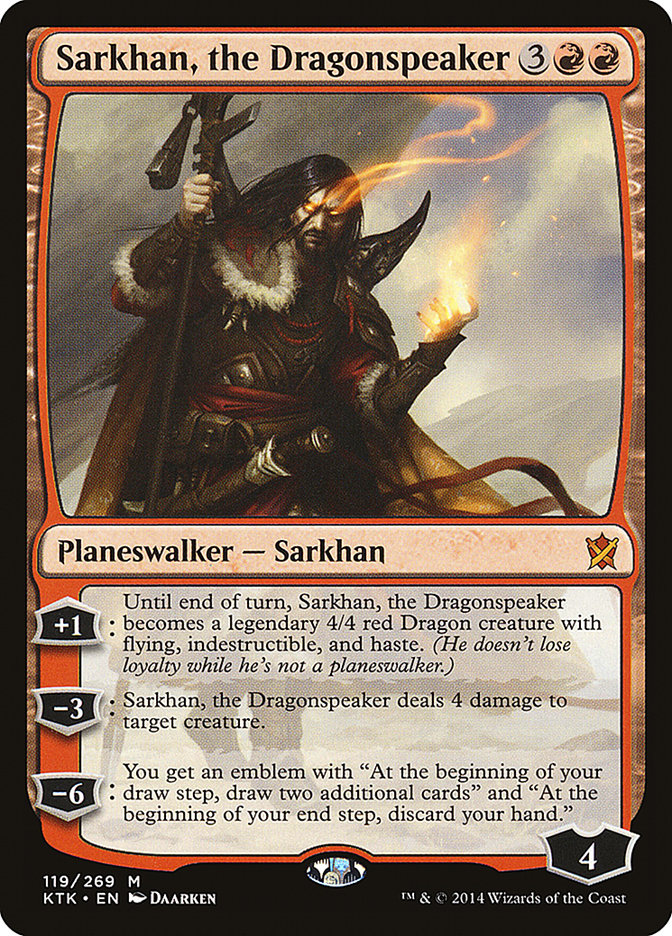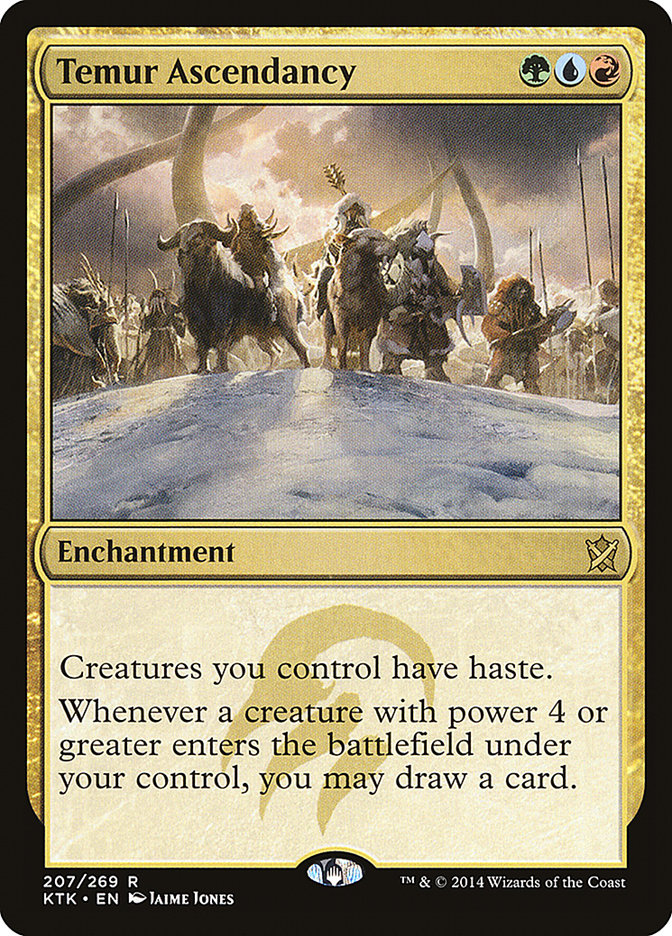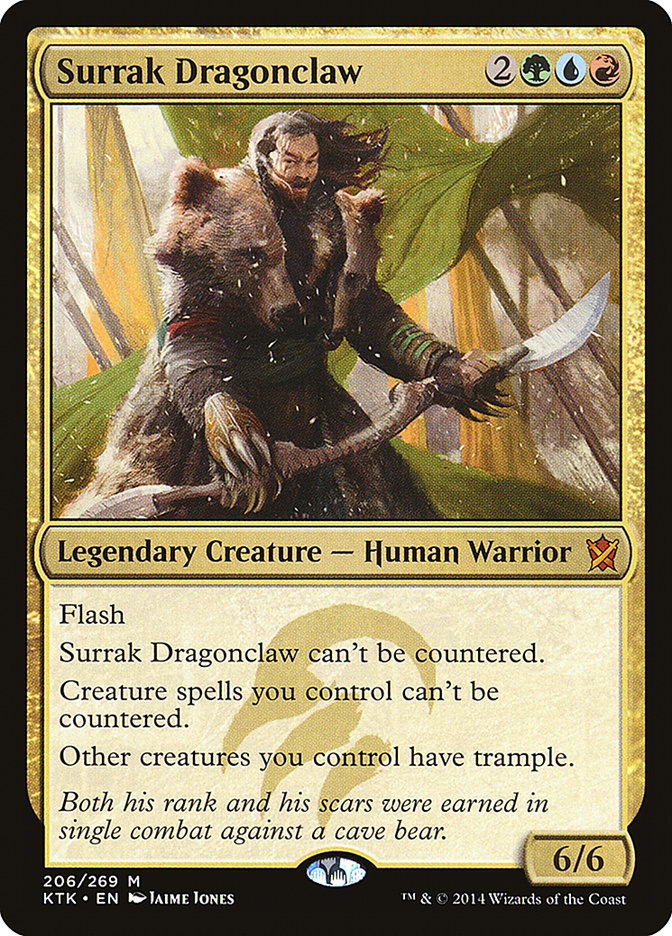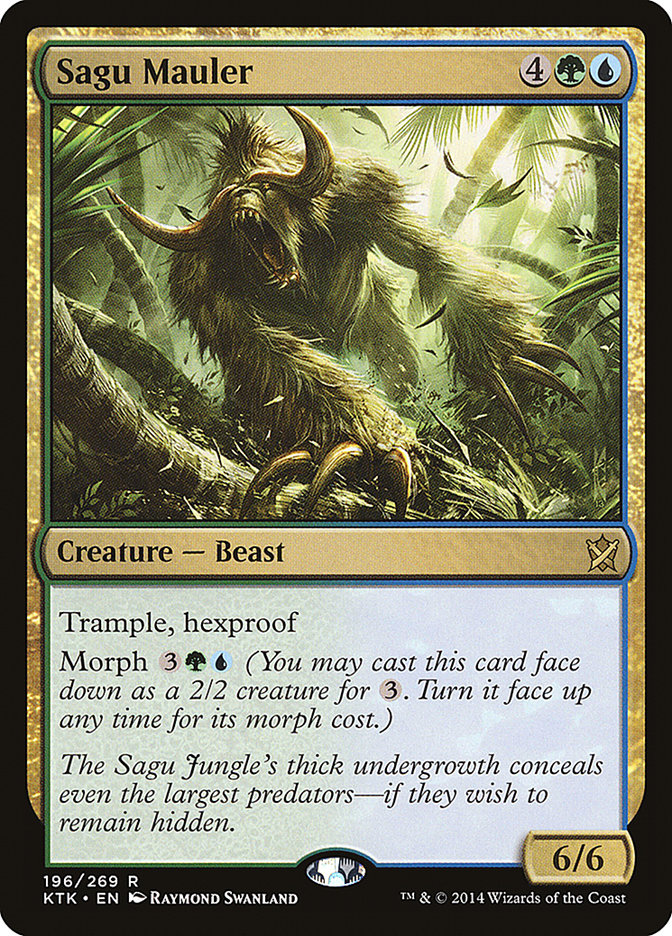You think people can just throw around lists with so many painlands and not get punished?
The Wrath costs five and the spot removal costs three?
Goblin Rabblemaster is legal?
…
The full Khans of Tarkir spoiler is now publicly available. That means it’s time to get down to brewing. One way to look at the new format is that it’s
Top 15 Highest Impact Post-Rotation M15 Cards:

The people that don’t play painlands are playing tons of tapped lands, and everyone has these ambitious three-color manabases that are dead if they
stumble.
It’s not hard to see, there are a lot of signs pointing to Mono-Red…
Theros Block Constructed with M15 and Khans of Tarkir. While M15 didn’t have the biggest impact on Standard, it does offer a lot when matched up against
Theros block.
14. Chord of Calling
13. Foundry Street Denizen/Frenzied Goblin/Hammerhand
12. The Souls – Most notably Soul of Shandalar
11. Sign in Blood
10. Negate
7. Aetherspouts
6. Planeswalkers – Chandra, Pyromaster and Nissa, Worldwaker most of all, but Ajani Steadfast and Liliana Vess are also worth noting.
5. Hornet Queen
1. Enemy Painlands – Yavimaya Coast, Shivan Reef, Battlefield Forge, Caves of Koilos, Llanowar Wastes
That’s a lot of red and green cards, right? I’ve seen people describing the format, at least at its onset, as basically being a clash between Courser of
Kruphix decks and Goblin Rabblemaster decks. I’m not sure I disagree. It’s so hard to come up with good reasons not to play Courser of Kruphix; and every
time I sketch out a deck without Courser of Kruphix, it always seems to have Goblin Rabblemaster in it.
For instance, obviously Mono-Red:
Creatures (22)
- 2 Frenzied Goblin
- 1 Stormbreath Dragon
- 4 Firedrinker Satyr
- 4 Goblin Rabblemaster
- 3 Borderland Marauder
- 1 War-Name Aspirant
- 3 Jeering Instigator
- 4 Monastery Swiftspear
Planeswalkers (3)
Lands (23)
- 23 Mountain
Spells (12)

Sarkhan, the Dragonspeaker versus Stormbreath Dragon is an interesting question in decks like this. They are both five-cost four-damage hasty threats that
dodge some of the good removal. Stormbreath Dragon dodges Abzan Charm, Jeskai Charm, Banishing Light, and Utter End, to name a few; while Sarkhan dodges
Sultai Charm, Murderous Cut, End Hostilities, and Elspeth, Sun’s Champion. Sarkhan’s other abilities give him added utility, particularly for shooting
Courser of Kruphix, Savage Knuckleblade, and opposing Stormbreath Dragons, but he also brings with him the liability of having to potentially protect him
against opponents with creatures on the table.
I’m starting with one of each to get a feel for how both play in the new format. It is interesting to note how well they work together though. End
Hostilties and Elspeth, Sun’s Champion in particular make it dangerous to play a second Stormbreath Dragon. If you follow up with Sarkhan, however, there
are very few ways of stopping both at the same time. This is much more applicable for a R/G/x Monsters sort of strategy, but worth keeping in mind.
23 basic Mountains? Shouldn’t we just be running a playset of Wooded Foothills and Bloodstained Mires? Believe it or not, the sweet, sweet virtual card
advantage of increasing your chances of drawing spells by around 1.3% every turn. That’s almost like drawing an extra card every 77 turns (assuming you
aren’t trying to draw land). Look, I love drawing extra cards as much as the next guy, but there is a price that is too much. How long does the game go on,
on the average, after you fetch? Six or seven turns? After all, sometimes you fetch on turn 5. Maybe you’re drawing an extra card every eleven or twelve
fetchlands. That’s a lot of life per card.
The real question is, what’s more likely to change the outcome of a game?
● The extra 1.3% chance of drawing a spell actually causes you to draw an extra spell, and then having an extra spell wins a game for you that you would
have lost if not for it.
● The life lost up front causes you to lose a game you would have otherwise won.
I don’t think it’s particularly close. Now, if you have any cards that want cards in the graveyard, that’s a totally different story. The same would be
true for any other fetchland synergies. For instance, Courser of Kruphix makes me want to consider fetchlands even in a mono-green deck because of the
ability to shuffle away a card you don’t want. That is a lot more than 1.3%. Literally the first card you would have drawn that you don’t want,
you can shuffle back, not to mention Courser making the life loss free.
One of the fundamental problems I see with a strategy like traditional mono-red is how heavily the format already encourages people to play five-toughness
creatures. Courser of Kruphix is the level one, making Stoke the Flames and Mardu Charm more popular than they otherwise would be. Add to that a desire to
stop Savage Knuckleblade and live through Sarkhan, the Dragonspeaker, and you have more people wanting to play Polukranos than would have before.
Where things get ugly is when you consider that one of the best cards in the set, Siege Rhino, is a 4/5 with an enters the battlefield trigger that
absolutely demolishes this strategy. It seems pretty obvious that Abzan is going to be one of the main decks to beat, and Siege Rhino is so good that
people are going to need a reason to not start with three or four in their deck.
Another challenge facing traditional mono-red is what to do about the two-spot on the curve. Borderland Marauder isn’t exactly at an inspiring power level,
but at least it does three damage. Jeering Instigator is a bit of a speculative addition on my part, but I kind of think it might be sick. Act of Treason
effects are very valuable in decks like this, and having the ability to buy some maindeck, in a sort of kicker way, is worth a ton for trying to actually
beat Siege Rhino and Polukranos, World Eater.
War-Name Aspirant is another option in the three-power department, and I might be totally underestimating its evasion ability. It doesn’t really dodge much
besides Elspeth tokens, right? I guess the real question is how often is it a 3/2, because if its 98% (which it’s not), than it’s probably better than
Borderland Marauder. So, where do you draw the line? I’m only playing one to learn a bit more about it, otherwise, I’d just play another Borderland
Marauder.
Mogis’s Warhound and Volley Dasher are reasonable considerations, but I feel like “must attack” is going to be a bigger drawback than usual this time
around. Mogis’s Warhound also opens us up to getting hit by Erase, which I expect to be a not-infrequent card to face.
Finally, among two-drops, Horde Ambusher looks okay if there is just a ton of blocking going on. Obviously, the more morphs you play, the better they all
are at obfuscating which ones you’ve drawn.
Ashcloud Phoenix is another option along those lines, and while that one doesn’t stack particularly awesome with other morphs (since you really want to
cast it face up), it is a totally reasonable option just on its own merits. Ashcloud Phoenix isn’t the fastest beatdown in the world, but it is pretty good
against End Hostilities, Hero’s Downfall, and burn. This list has opted for Chandra, Pyromaster, trying to be focused on the fast beatdown, but with so
much of red’s power tied up in three, four, five, and even six cost threats rather than ones and twos, I feel like red decks need to go more extreme.
Either they need to slow down and play a more big red style that takes advantage of their powerful cards, or they need to go all-in on speed, perhaps with
a Heroic angle.
One card we haven’t touched on yet is Monastery Swiftspear. I kind of think that card might be underrated. First of all, the competition isn’t all that
high. More importantly though, the one-point of haste is not trivial, and this ability is deceptively strong here as it makes combat very dangerous. If
your opponent has two 2/2s, are they going to block when you attack? If they do, a Lightning Strike kills both!
Monastery Swiftspear gets even better if you can find room for even more spells (shocker). What about Red Heroic? That’s a deck that both appreciates a
Raging Goblin and casts an above average number of non-creature spells.
Creatures (22)
- 3 Frenzied Goblin
- 4 Foundry Street Denizen
- 4 Akroan Crusader
- 4 Firedrinker Satyr
- 4 Goblin Rabblemaster
- 3 Monastery Swiftspear
Lands (19)
- 19 Mountain
Spells (19)

Hordeling Outburst is pretty sweet, if a bit expensive for the Boss Red style of aggro. The nice thing though, is that it triggers both Monastery
Swiftspear and Foundry Street Denizen, and in fact, makes the Denizen absolutely explode in damage. If we did want to play up that aspect of the deck, we’d
probably want to cut the Akroan Crusaders and the Hammerhands, moving towards a more Hall of Triumph setup. Alternatively, we could cut some burn, but then
our Rabblemasters get a little worse.
Of course, Monastery Swiftspear and Foundry Street Denizen kind of take you in opposite directions. Foundry Street Denizen has a lot of things going for it
at the moment, so maybe we should take a closer look at it. You know, it is a goblin, and the number of goblins has increased a fair bit. Could we be
closing in on the return of a Goblin deck?
Creatures (24)
- 4 Frenzied Goblin
- 4 Foundry Street Denizen
- 4 Firedrinker Satyr
- 4 Goblin Rabblemaster
- 4 Jeering Instigator
- 4 Butcher of the Horde
Lands (23)
Spells (13)

There’s not quite ideal Obelisk of Urd quantities of Goblins, but we’re not that far off. If we had a good two-cost Goblin, maybe even another playable
one-drop, so we could replace the non-Goblin Firedrinker Satyr, we could be kind of doing it.
As for the double splash, there’s a good chance it’s a bad idea, but Mardu Ascendancy fits so perfectly that I think it’s worth a shot. Besides, Butcher of
the Horde is real strong and Goblin Rabblemaster works absolutely incredible with it. The Rabblemaster makes tokens in time to give the Butcher whatever
ability it wants, and the tokens are often destined to die anyway from having to attack. The Butcher ensures you get some value out of them. Besides, it’s
close to impossible to race a Butcher if it has a limitless supply of food.
Butcher of the Horde is a pretty filthy card, though I do think it will die more than people realize. Everyone compares it to Falkenrath Aristocrat, but
the Aristocrat was indestructible. Butcher of the Horde dies to basically every removal spell, aside from Lightning Strike, Bile Blight, and Sultai Charm.
That said, it is 5/4 flier for four. That is already in the right neighborhood to be a boss, and these three abilities push it well into flagship
territory. Being able to sacrifice a creature to get in there on its first turn is already so big, but if you actually have the kind of food needed to give
it lifelink? How can you beat that without removal?
Butcher of the Horde is a devastating combo with Jeering Instigator, letting you steal their best creature and bash them with it, then sacrifice it.
Alternatively, you can also just sacrifice it right away to get some more sweet lifelink or vigilance action, depending on your needs.
Taking this even further, Harness by Force is a super sick combo with Butcher of the Horde. If the damage doesn’t kill them, killing their two best
creatures while swinging for a ton probably does. If we want to push this theme even further, we could use Tymaret, the Murder King as an additional
sacrifice outlet to combo with the Jeering Instigator and Harness by Force.
In considering red decks, red devotion is an obvious possibility that springs to mind, though it’s not a great fit for Goblin Rabblemaster:
Creatures (25)
- 2 Purphoros, God of the Forge
- 3 Stormbreath Dragon
- 2 Fanatic of Mogis
- 4 Eidolon of the Great Revel
- 4 Prophetic Flamespeaker
- 4 Goblin Rabblemaster
- 2 Soul of Shandalar
- 4 Jeering Instigator
Planeswalkers (5)
Lands (25)
Spells (5)

Both Goblin Rabblemaster and Prophetic Flamespeaker want you to play with more removal to clear a path for them. Nykthos, Shrine to Nyx, Purphoros, God of
the Forge, and Fanatic of Mogis all want you to play as many red permanents as possible and avoid much burn. Besides, trying to support both of the four
cost red devotion cards eats into space that could be used for Chandra, Pyromaster, a card that’s great with both Rabblemaster and Flamespeaker.
Another problem with this implementation of red devotion is that losing Frostburn Weird and Boros Reckoner makes our ability to lock up the ground
seriously diminished. Red devotion was a strategy that benefited from slowing things down, then building up to big haymakers. Jeering Instigator and Goblin
Rabblemaster are not the greatest at defense.
So, what is good about this list? Well, Nykthos, Shrine to Nyx is totally sick with Soul of Shandalar. Just having this many big red powerhouses is a lot
of goodness, and in fact, there are so many good expensive red cards, and so few cheap red cards that are good at blocking, it makes me wonder about moving
in a little more “Big Red” of a direction. Could Anger of the Gods be a thing? Alternatively, what about Ashcloud Phoneix? It is a pretty good blocker.
Of course, there’s still the big question of why we’re not splashing blue for Mantis Rider and Jeskai Charm, or splashing black for Butcher of the Horde,
Crackling Doom, and Mardu Charm.
Creatures (11)
Planeswalkers (8)
Lands (25)
Spells (16)

The problem here, of course, is the lack of meaningful one and two-mana plays. Maybe we’re supposed to play more mediocre burn, but it just seems like it’s
going to match up so poorly against the mid-rangey strategies people are going to play.
One possible solution is to crutch on sweepers like Anger of the Gods or End Hostilities. Another possibility is to massage the manabase a little to
include early creatures like Soldier of the Pantheon, Dauntless River Marshal, and/or Brimaz, King of Oreskos.
I think Jeskai might be the most underrated charm. I’ve seen people calling it the worst, and I think it might actually be one of the two best. I mean,
most of the Charms are pretty close together in power level, so it’s a tight race, whichever comes out ahead. All five are pretty good, you know?
So, why do I love the way Jeskai Charm is looking? Well, most of the modes on most of the charms
are two-cost spells. Putting a creature back on top at instant speed without it needing it to be combat? That effect has generally always costed four mana.
Here, we get it for three, plus we have two other modes!
Putting a creature back on top is a very underrated ability, which is part of why Azorius Charm was always so frequently underrated. Of course, Azorius
Charm could cycle to draw a card, but Jeskai has a different sort of cycling. Dealing four damage to a player is actually a fantastic ability on a charm,
since it is so good when its good, and when it’s not, just use a different mode. You can basically always use the creature on top ability except against
opponents with planeswalkers…
And against them, all you want is to draw a burn spell to kill the Planeswalker! Jeskai Charm outright kills Kiora, Xenagos, and Nissa, while putting
Sarkhan on top of the deck. Elspeth survives, but four damage can go a long way towards wearing her down. Besides, sometimes you don’t go after
planeswalkers, but rather the opponent’s face. When they’re at eight, it sure is nice to have a bunch of Fireblasts in your deck…
“What about fast aggro?”
you might be asking. “A three-cost repel isn’t exactly what I want against one and two-drops.”
Good point. Let’s take a look at that third ability…
Oh, a combat trick that can dominate the board while also gaining an enormous amount of life? This card is awesome. It has a reliable mode to make sure
it’s always solid, and then it has two niche uses that are often incredible whenever it’s appropriate to use them. That is perfect distribution for a
Charm. As if all of this wasn’t enough, white, blue, and red also appreciate three-cost spells more than all of the color combinations that compare every
new card to Hero’s Downfall.
I would play four Jeskai Charms in every Jeskai deck, no matter how fast or slow. I mean, maybe there’s some control deck that has too many other threes,
no creatures to pump, and no pressure to capitalize on the burn to the face; but I’m not even sure why we’d set a Jeskai deck up that way, instead of using
Sarkhan, the Dragonspeaker and maybe Mantis Rider.
Mantis Rider is just a great Magic card, and even though its stats put it behind against Bile Blight and Lightning Strike, it really benefits from just how
many awesome four-toughness creatures are out there. Courser of Kruphix, Savage Knuckleblade, Brimaz, Anafenza, Stormbreath Dragon, and more all really
push people to play with more expensive removal (Stoke the Flames instead of Lightning Strike, Silence the Believers instead of Bile Blight, etc). This
plays right into Mantis Rider’s gameplan.
Mantis Rider really beats up Xenagos, the Reveler, so much so, that when playing a R/G/x Monsters deck against an opponent with Jeskai mana, you’re often
going to want to plus it the turn you play it. Of course, that isn’t always the best tempo play, and you risk putting yourself in a spot where Sarkhan, the
Dragonspeaker or Stormbreath Dragon just kills Xenagos outright.
Kiora gets it from Mantis Rider even worse, as she really doesn’t have a good way to get out of it. You can use the -1 ability, so that at least you don’t
go down in cards, but it’s a poor tempo play. You can try to wait and play Kiora after the Mantis Rider, but that’s another poor tempo play and risks
getting hit by any other burn or haste creature.
Planeswalkers, in general, are really under the gun:
Nissa, Worldwaker may live through Mantis Rider, but she ends up looking like Abobo after getting pummeled by Billy and Jimmy Lee, the Double Dragon brothers. Once you factor in the
loss of shocklands, we might start to wonder if Nissa still has a place in the format. I think she does, as her power level is just real high to begin
with, and even if you only have two actual Forests in play for her untap ability, she curves into Hornet Queen (and makes quad-green trivially easy).
Hornet Queen is poised to be one of the premier endgames in the format. It was already a fantastic card, but Lifebane Zombie stepped on it incredibly hard.
Supreme Verdict also smashed it, and the popularity of Dissolve didn’t help.
There are going to be less End Hostilities than there were Supreme Verdicts, and Lifebane Zombie can be forgotten like a bad dream. Hornet Queen also
matches up awesome against so many of the other best endgames, like Stormbreath Dragon, Sarkhan, the Dragonspeaker, and Elspeth, Sun’s Champion.
Costing seven, it’s hard to really cast Hornet Queen without using some sort of acceleration, but it’s not totally clear why you wouldn’t want acceleration
anyway. There are so few meaningful things to do on turns 1 or 2, the possibility of skipping up higher on the curve is damn appealing.
Creatures (27)
- 2 Hornet Queen
- 4 Elvish Mystic
- 4 Polukranos, World Eater
- 4 Sylvan Caryatid
- 3 Stormbreath Dragon
- 4 Courser of Kruphix
- 2 Soul of Shandalar
- 4 Rattleclaw Mystic
Planeswalkers (7)
Lands (23)
Spells (3)

There are plenty of good accelerators and plenty of good bombs to accelerate into. This plays right into the black removal player’s gameplan, of course,
but I think the bigger question is why aren’t we splashing blue? Savage Knuckleblade is just so insane, and both Temur Charm and Temur Ascendancy are worth
considering.
Creatures (28)
- 4 Elvish Mystic
- 4 Polukranos, World Eater
- 3 Sylvan Caryatid
- 2 Stormbreath Dragon
- 2 Boon Satyr
- 4 Rattleclaw Mystic
- 3 Sagu Mauler
- 4 Savage Knuckleblade
- 2 Surrak Dragonclaw
Planeswalkers (3)
Lands (23)
Spells (6)

Yeah, that’s probably foolish. We’ve even got plenty of other enchantments for enchantment kill to target. I guess I just wanted to try coming with more
four-power dudes. If I were going to play this in a tournament tomorrow, I’d definitely want to make room for them.
Temur Ascendancy is scary as funk in this list, with Polukranos, Surrak, and Sagu Mauler bashing Fires of Yavimaya style while drawing tons of extra cards.
While the expensive fatties are pretty easy to spot, Boon Satyr is an easy one to forget about, being lower on the curve.
Crater’s Claws hasn’t gotten much love yet, but it’s one of the better rewards for playing Ferocity. Early, it kills mana creatures or two-power one-drops.
It’s efficient at dealing with big threats like Elspeth, and later, it turns manaflooding into an advantage.
By contrast, Surrak Dragonclaw doesn’t actually excite me very much. I generally like Stormbreath Dragon and Sarkhan, the Dragonspeaker more, but if we’re
going to do the whole Temur Ascendancy thing, we gotta give him a fair shot. Interestingly, it’s the trample ability that most excites me about him (well,
that and having an outrageously large body). The ability to give Savage Knuckleblade and Polukranos trample as a surprise is an awesome way to combat
Elspeth, not to mention flashing down end of turn, after Elspeth -3s to kill your Polukranos.
Sagu Mauler, on the other hand, is a six-drop I can really get behind. I do like Soul of Shandalar too, and it’s very possible that we just want the
activated ability to take over the game. After all, black removal is going to be very overworked against us, and Soul of Shandalar isn’t the worst against
black removal anyway. Still, there is just so much incidental black removal, I really feel like they might just never run out. That’s where Sagu Mauler
comes in. Just play around Elspeth, and you’re good to go. Remember, if you have eight mana, you can play the Mauler as a morph, so it can’t be Elspeth’ed.
Then, at your leisure, flip it into the Mauler. Even if they have two removal spells, they can’t “get you,” as morph doesn’t use the stack. Just remember,
if you morph it, you won’t draw a card off Temur Ascendancy.
The threat of Sagu Mauler also makes Rattleclaw Mystic scarier as the game goes on. Your opponent will have to think twice about blocking your morphed
Rattleclaw since it might turn into a 6/6 hexproof trample at a moment’s notice. Ashcloud Phoenix is another morph to consider, particularly since it has
the much desired four-power. I wouldn’t be surprised if it’s just not right to play Xenagos at all anymore. The world is so hostile towards him and he
doesn’t trigger your combos. At least making a million mana is sweet with Crater’s Claws.
On the topic of morphs, I’m kind of curious about Hooded Hydra. It’s not actually the worst to just run it out there as a 3/3 for five or a 4/4 for six
that dies into tons of little guys, but the real strength comes in morphing it. Let’s say they play End Hostilities, fearing your morph is a Sagu Mauler.
Surprise! It turns out to be a Hooded Hydra, and now they are taking five on the swing back (if not nine, thanks to the plethora of haste creatures). The
only thing having me pumping the breaks a little on the Hooded Hydra is just how much steep competition there is, not to mention it doesn’t naturally mesh
with ferocity quite as well.
What’s the best red to play? I mean, there’s definitely going to be at least four major red decks, day 1:
● Temur
● Jesaki
● Mardu
● Mono-Red
And frankly, there’s probably going to be multiple shades of each of these, as Khans of Tarkir has done a fantastic job (so far) of presenting tons of
worthwhile options to explore, with the best path forward far from obvious.
I think the biggest questions facing red mages basically boil down to:
● Power or speed? The best red cards are expensive, but the format looks vulnerable to speed.
● Mono or Wedge? Mono-Red’s mana is flawless, of course, but each red wedge has multiple killer three-color powerhouses.
● What’s the plan against creatures that don’t die to Stoke the Flames? There are definitely going to be a lot of those…
I’m not sure I can avoid playing Courser of Kruphix in October, but if I do, it’s probably a red deck; and many of the Courser of Kruphix decks are going
to be red. One thing’s for sure:
It’s time to brew some rouge decks…




